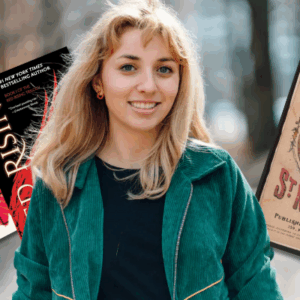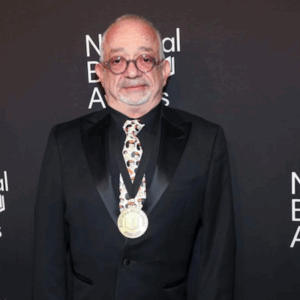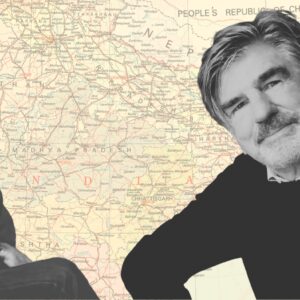
Emma Donoghue on Populating Historical Fiction
“Instead of a permanent policy on how true my fictions need to be, I negotiate a set of rules with myself for each particular project.”
This first appeared in Lit Hub’s Craft of Writing newsletter—sign up here.
It began with a photograph. I’d searched for “history Montparnasse” because that was the neighborhood where we were going to spend a year. I knew nothing about this area of Left-Bank Paris apart from its bone-decorated catacombs and a few famous hangouts of Picasso, Hemingway, et al.
Up popped multiple copies and variants of the image, some by named photographers and some anonymous, all showing an impressive steam train—a wonder of 1890s tech—dangling surreally out of the smashed façade of a railway station.
After ten minutes of skimming sites, I knew I had my next novel. It was clear at once that The Paris Express should be confined to this one train from the Normandy coast to the capital, on the one day when everything went wrong, 22 October 1895. My story should move forward like the train itself, starting slow but gathering speed.
I would describe most of my books as fact-based historical fiction. The reason I use that qualifier is that historical fiction also includes novels with a much more po-mo or devil-may-care approach to the recorded past, and that’s fine too—I just prefer to signal to readers that I’m over here on the nerdier end of that spectrum, checking the fine print of indexes, timetables, and, increasingly, databases and genealogy sites. (Visual sources, too; I’ve found many a helpful detail in photographs for all my novels set after the mid-nineteenth century.)
But instead of a permanent policy on how true my fictions need to be, I negotiate a set of rules with myself for each particular project. On several occasions I’ve taken a detective-like pleasure in working within and around all the facts I can dig up about the more or less forgotten lives I’m trying to reanimate. This has been easier with the poor (a sex worker and maid in Slammerkin) than for the rich, who’ve left hundreds of volumes of letters behind (lords and ladies in Life Mask). By contrast, The Wonder is a fictional story, inspired by dozens of real cases of “fasting girls” and borrowing details from each, but tied to the specifics of none of them, because some cases were too silly and some were too shatteringly sad. And The Pull of the Stars is an invented story set during the real Spanish Flu pandemic in 1918… but one real doctor-cum-revolutionary, Kathleen Lynn, insisted on striding out of background research and planting herself in the middle of my fiction.
For The Paris Express, from the forty articles about the Montparnasse Derailment in twenty-six French publications (preserved in the Bibliothèque de France’s wonderful free library) I was soon in possession of plenty of facts about Engine 721 and her the four-man crew. (The railway company put the same driver, stoker, and engine on the same run every day, on the assumption that the better the men knew each other, the quirks of their feminised machine, and the landscape, the better performance the crew would be able to squeeze out of her over the ups and downs of the route, as they balanced side by side on the footplate, exposed to all weathers and deafened by noise.) Thanks to the ever-bureaucratic French state, in the hoard of records at filae.com I was able to track down wonderfully suggestive details on these men, their addresses, wives, military service… When I saw that the driver, Guillaume Pellerin, had a father and a son of the exact same name buried with him in Montparnasse Cemetery, both (like him) train drivers for the Company of the West, I realised that this wasn’t just a job, it was more like being in the mob.
Having rules to follow, whatever they may be, does preserve your sanity when you’re tackling the sustained and strangely schizoid challenge of spinning a fiction out of a “true story.”
Hang on, though, who were Pellerin’s passengers that day? The Express could have held over a hundred. The journalists who rushed to the scene managed to jot down the names of about a dozen—the VIPs (there were three members of parliament on the train that day, which was a factor in the disaster) and a couple of servants. Nineteenth-century reporters could be extremely casual with facts and guessed at the spelling of names. (One woman was given as Madame Aguilard, Aguillard, Aiguillard, Aquilard, Aguélard, or Gillart.) The journalists only secured an interview with one passenger, a level-headed politician and armaments tycoon who said he’d guessed the train was going to crash and warned his wife and her friend to climb up on the velvet banquette so their legs wouldn’t be severed in the event that their First Class carriage got telescoped into the next.
So the biggest decision I had to make about The Paris Express was how to fill those carriages. Any novel about a train is a study of society and its ineradicable divisions. (No velvet in Third Class, just overcrowded, backless benches, and the third class carriages were always positioned at the back, to be crushed first in the event of a collision from the rear.) I needed lots of other people, then, and at first I assumed I’d be inventing them.
But as soon as I plunged into background reading about the kinds of painters, scientists, writers, inventors, artisans, aristocrats, students, radicals and queers who were living in Northern France in the 1890s, I realized that this was a dazzling pool of potential characters. Belle Epoque Paris, the heart of a wide French empire, was also a hub of modernity that magnetically drew a wider range of people than any place I’d written about before. Paris had expats from Philadelphia and Cuba, students from Ireland and Cambodia… I ended up only needing to invent two named characters. (One of them, a coffee-seller staggering about all day with a hot tank strapped to his back, like a human Starbucks, was suggested by a painting I spotted in a museum of the history of Paris.) The remaining fifteen are all real people who could plausibly have caught the train that day—and there’s nothing to say that they didn’t.
These are arbitrary rules, of course, and a different writer would do it differently. But having rules to follow, whatever they may be, does preserve your sanity when you’re tackling the sustained and strangely schizoid challenge of spinning a fiction out of a “true story.”
In certain sources, silence speaks loudly. The Montparnasse Derailment didn’t even rate a mention in that year’s Revue générale des chemins de fer (General Railways Review), an absence which drew my attention to the reality that trains quite often crashed, killing passersby, passengers, or (far more often) workers on the line, and everyone tacitly accepted this as the price of speed and convenience, as with cars or child labor today.
Some details and whole storylines in The Paris Express came not from the facts I tracked down but from the gaps between them, the things not explained in the historical record. When I grasped that French trains of the 1890s had no communicating corridors—that my characters couldn’t hurry from one carriage to the next for interesting reasons, the mainstay of every train movie from The Lady Vanishes to Snowpiercer—I was briefly stumped, till I decided that compelling them to sit tight till the next station could establish a sort of hectic, Musical-Chairs rhythm.
But given that these trains lacked a dining car or trolley, what kinds of picnics did passengers carry? And given that trains also had no toilets, how did people manage? I wanted to include all human life, from birth to death, passing through sex, but how on earth could I make that happen? It’s strange, considering what relish I take in squirreling out the minutiae of how things really were and what actually happened, what an equal pleasure I find in having to make some things up.
_______________________________________
The Paris Express by Emma Donoghue is available via S&S/Summit Books.
Emma Donoghue
Born in Dublin in 1969, Emma Donoghue is an Irish emigrant twice over: she spent eight years in Cambridge doing a PhD in eighteenth-century literature before moving to London, Ontario, where she lives with her partner and their two children. She has written literary history, biography, stage and radio plays as well as fairy tales and short stories. She is best known for her novels, Slammerkin, Life Mask, Landing, The Sealed Letter, Stir-Fry, Hood, Landing, and the international bestseller Room a finalist for the Man Booker, Commonwealth, and Orange Prizes.




















